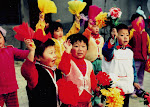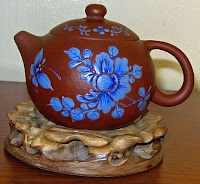 |
| A Chinese mom-to-be's preparation for baby. |
We received joyous news last week. A young Chinese woman I have known for almost 20 years gave birth to her first baby, a healthy boy, in Shanghai.
I first met the new mother when she was 12 years old; her parents asked me to tutor her in American English. She turned 30 years old just three weeks ago. We kept in touch over the years, seeing her and her family whenever we visited China. She's been to the United States twice to visit us.
Having a baby in China is a lot different than having a baby in the United States. For one thing, her husband says new fathers pass out hard boiled eggs to celebrate the baby's birth. This is much healthier than passing out cigars like new fathers do here, don't you think?
Another way having a baby in China is different is the red tape involved. Because
of China's one-child policy, prospective parents must get permission from local governments to have a baby. Then they can get pregnant. Our friend got pregnant first. Not good. They couldn't get permission to have the baby in Shanghai because they are not
hukou for Shanghai.
I'm not sure I understand all that is involved in hukou, but it's like a permanent residency system. Even though our friends went to university in Shanghai, have lived there ever since and bought an apartment there, they are still considered temporary Shanghai residents. From what I understand, changing one's hukou is a process that takes many years, not something they could do in nine months. She still could have had the baby without this permission, but she would not have been able to have it in a hospital, and would get no official papers for the child, which meant he could never attend school or hold a decent job.
She is hukou for Beijing, and that's where she was finally able to get permission to have the baby.
The next step was getting accepted at a hospital that would provide the prenatal care and handle the birth. The application process included a personal interview. She was accepted at the second largest maternity hospital in Shanghai, which was her first choice because it is the closest to their home.
Once you get accepted at the hospital, then you have to decide the level of treatment you want. Basic care, which is paid for by the government, involves standing in long lines to get prenatal care. The other option was to pay the equivalent of several thousand U.S. dollars for care that put the mother-to-be at the head of the line and gave official notice of the baby's sex. Our friends opted to save the money, and would arrive at the hospital at 6 a.m. to avoid the lines; they were given an ultrasound picture of the baby, so they knew they were going to have a boy.
Modern Chinese mothers are breaking with tradition of returning to their parents' home for a few months while they recuperate from the birth and learn how to care for the infant. Modern parents are more mobile than their parents, and may live thousands of miles away, so many new mothers today opt to hire a nurse for the first month, according to a
recent article in China Daily. Our friend had her nurse lined up several months ago and already has a babysitter lined up for when her maternity leave is over and she returns to work.
Are you going to China?
If a trip to China is in your plans, check out
Cheryl's China, and feel free to
email me with any questions you might have.
 When I was a writer for Suite101, I wrote dozens of articles about China, frequently mentioning them on this blog with a link to the Suite site.
When I was a writer for Suite101, I wrote dozens of articles about China, frequently mentioning them on this blog with a link to the Suite site. 



















